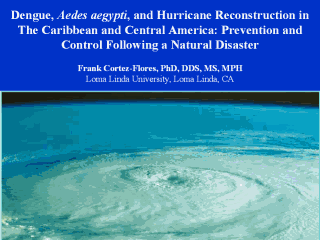|
|
|
|
front
|1
|2
|3
|4
|5
|6
|7
|8
|9
|10
|11
|12
|13
|14
|15
|16
|17
|18
|19
|20
|21
|22
|23
|24
|25
|26
|27
|28
|review
|

LEARNING OBJECTIVES Upon completion of these presentations, the learner should be able to: · Examine and explain the growing significance of disaster mitigation and strengthening regional surveillance networks for dengue and dengue hemorrhagic fever following a natural disaster (e.g., hurricane). · Define how to strengthen the regional capacity for effective implementation of prevention and control strategies for disaster mitigation. · Emphasizes the practical application of field research in the management and control of the dengue vector, Aedes aegypti, following a natural disaster as well as promoting the further development of applied research in the areas of rapid diagnosis, epidemiology, and prevention. · Describe an interdisciplinary team approach to achieving success with prevention and control programs. Emphasizing national and regional infrastructures for early warning of and rapid response to infectious disease threats, following natural disasters, through laboratory enhancement.
|
Frank Cortez Flores, Ph.D., D.D.S., M.S., M.P.H. Department of International Health, School of Public Health Loma Linda University E-mail:
fcflores@ix.netcom.com My primary public health interest is the reemerging
arboviral infections (e.g., dengue fever) that are increasing in incidence,
expanding into new geographic areas, affecting new populations, and are
threatening to increase in the near future, especially following natural
disasters. The goal of the dengue
lecture series is to promote the recognition of dengue and dengue hemorrhagic
fever and improve the understanding of factors involved in prevention,
surveillance and control of the Aedes aegypti mosquito, the principal
mosquito vector of dengue virus.
The paramount purpose of this lecture is to accelerate learning and development of an effective dengue prevention and control response plan for disaster mitigation. The theme of the lectures/ presentations is awareness and learning. The general nature of a dengue fever outbreak threat following a natural disaster and the resultant need for a well-designed preparation response and recovery create a demand for services and resources that cuts across an array of responsible and affected stakeholders. |
More
in-depth information on Dengue, Aedes
aegypti and Natural
Disasters can be found at the following Internet links:
Dengue,
Aedes aegypti and Natural Disasters URL:
http://www.paho.org/disasters/
http://www.who.int/ctd/docs/dengue.pdf
http://www.paho.org/English/HCP/HCT/feti-dengue.htm
http://www.cdc.gov/ncidod/index.htm
Spanish
text:
http://www.paho.org/desastres/